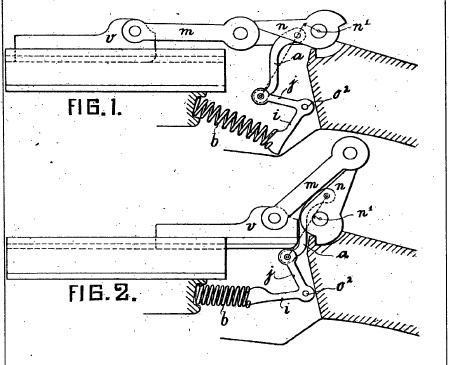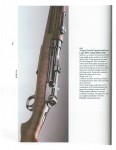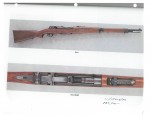Georg Luger adapted his famously successful toggle lock form the Luger automatic pistol into a self-loading rifle for the German military. It was built in 8mm Mauser, but only a few prototypes were ever built.

According to the related patent (which you can download below, thanks to a fellow name JonMac who found if for a post on The Firearms Blog) the rifle incorporates an improvement over the Luger pistol mechanism. The pistol was known for having minimal spring pressure holding the toggle closed – a little dirt in the chamber or a bumping the cocking knobs upward could inadvertently keep the action from going fully into battery. This rifle design uses a different setup to put more positive spring pressure on the toggle when closed. This would probably not have been very easy to retrofit into the Luger pistol, simply because of space constraints.

Patents
UK Patent 4126 (Georg Luger, “Improvements in Recoil Operated Fire Arms”, July 26, 1906)
Photos



WOW, what a unique piece. Wish they had been mass produced. I’ve always been a fan of the pistol, and would love to have the opportunity to shoot a Luger rifle.
What a beautiful rifle. I’d love to see one of these in person. Love the site guys. Keep up the good work.
I once had the opportunity to handle one of these which was owned by Interarms and was in their private collection whilst they had a branch in Manchester UK. If my memory serves me correctly it was numbered ‘4’ on the woodwork. I can tell you the weapon has a VERY strong recoil spring and was unsuccessful largely due to the necessity for such a spring, and apparently suffered frequent stoppages. Production was stopped after a few prototypes as the problems could not be resolved. ( so I was told at the time). Glad I had the opportunity to see it though – I doubt I’ll ever see another. I believe the weapon was shipped back to Viginia when Interarms closed their Manchester site.
Do you know wheter this firearm used a detatchable magazine or a stripper fed, internal one, and how many rounds were able to be held in it?
About the magazine: If you enlarge picture 1 (where the rifle is ‘vertical’ on the page) you can see the guide for stripper clips. In the same picture, the floor plate shows a hinge at the front and a thumb latch at the rear, for quickly and safely unloading the internal magazine. I wish the US Army had looked at that in 1936.
I’ll bet that, if Germany had used that rifle in the trenches, they would have quickly and easily modified it to use removable magazines. Of course, in the trenches the Kar. 12 (or whatever they would have called it) would have needed a two-rifle two-man crew: one to shoot both of them alternately, and one to clean them.
I came to looking this rifle up because I saw a vid clip of pre WW2 British Army testing demo, along with a V.K. Berthier M/G (Bren taken up instead). Much like the Garand it ‘spits out’ the charging clip when empty. Not sure what went further: the clip or cases!
Any idea where I could find this video?
I would give my left testical to see you guys make a video on it and take it apart.
It was striper clip fed and held up too 5 rounds.
It was internal magazine fed I believe. I would assume it would have 5 rounds capacity
5 round internal block magazine.
I saw on Gunwicki fandom that it had a 5 round internal magazine.
It’s Gum Wiki Fandom, that says it has a 5 round internal magazine.
I would like to know more about this rifle and was wondering if ther is anything else you could tell me.
David, do you know if the Luger 1906 is still on display at Interarms?
Perhaps with a smaller caliber, the need for a stout recoil spring would be negated. I’d still very much like to see one of these rifles “in the flesh”. New production guns in smaller, workable chamberings would be very welcome.
I am sure you are correct Bill. It was the necessity for the weapon to use the standard 7.92 cartridge that was the problem. The cartridge is too powerful for this design to function without the powerful spring. I’m sure a lighter cartridge would have solved the problem, but would have been unacceptable to the German military. I wonder if Interarms allows visitors to it’s collection in Alexandria, Virginia? I’m sure that is where this weapon is now.
It’s shape is similar to Garand rifle
I agree,I thought that too.
There is one such rifle in the museum of the Irish Permanent Defence Force in the Curragh, Co. Kildare, Republic of Ireland. How it got there is not known.
If anybody is interested, please post your interest on the shooting forum of boards.ie
Thanks.
tac foley
President – Vintage Classic Rifle association of Ireland [www.vcrai.com]
Say, it would have been really uncomfortable if that toggle mechanism hits your face while you are aiming down the sights.
For anyone interested there is some info about the rifle in The Borchardt & Luger Automatic Pistols, vol. 2, p. 1649-1650, 1652-1655
does it mention if its short recoil operated or if it has a fixed barrel? im wondering how a short recoil rifle would would work with a bayonet attached.
The movie, “The American” with George Cluny features some version of this rifle with a folding stock. It’s referred to as a luger m14.
Crying out loud, doug! That was a Ruger Mini-14, not a Luger. It was also a pretty ridiculous bit of movie fantasy, Mini-14s are mediocre sniper rifles.
Since the recoil spring is actually more than one spring I can’t imagine the operating forces for loading being that high. There is a spring for the toggle and another 2 springs for the barrel, to return them to battery. When pulling the toggle to load a round you aren’t pulling on all the springs and therefore the effort should be low. When firing the springs for the barrel and the toggle are operated by the recoiling parts and absorb the energy in a normal manner.
Much information on these obscure weapons is hearsay and not factual. Its passed on by those who have no real experience and at some point becomes fact to the masses. Case in point is the post on this rifle at historical firearms which states that there is a thumb safety located on the rifles tang. This is not a safety it is the takedown lever for the trigger guard. Guess, guess, guess and when you’re not sure make stuff up. Ian hogg would be proud.
Timmy
Was M1 Garand based on its design?
@Rafael, lookup RSC 1917
I would love to have a replica of this one made for collection and fun use at the range or classical target competition!!
I can say it’s a nice design how ever it it not a rival design to the garand to small of a cartridge to be even effective as a service rifle witch would most likely be the common 9mm or a 7.62x21mm it would be mostly useful as a sports rifle or a collectors and that time in WW1/2 the military rifles were mostly manufactured and civilian versions modified from the full blown military varient.
The rifle I saw at Interarms UK was definitely chambered in 7.92 x57
The Luger rifle was only offered for the US Navy/Marine Corps contest for a small calibre rifle in 1894. The Navy Small Arms Board decided on a calibre of 6mm, with a semi-rimmed case(6mm Lee Navy).
During two series of test firings, the Luger rifle so impressed the board that it recommended purchase of either a prototype or an option to purchase the rights to manufacture. However, the Luger rifle had one major disadvantage; it failed to meet the basic board specifications, having been chambered in a non-standard, rimless, 6mm cartridge.
Luger did not offer to resubmit the weapon in the official calibre, and withdrew the rifle from consideration before the third series of tests began.
The US Nsvy and Marine Corps decided to adopt the Lee Navy rifle.
It would probably have served well, given that the US forces of the period were long service regulars, as opposed to the European model of mass conscript armies.
The Luger rifle submitted for the Navy Trials was a turnbolt.
What a fantastic website. I’ve been following Ian’s YouTube videos for years (and am constistently astounded that there always seems to be a video about what I’m looking for) but this is the first time i’ve actually seen an article on the website. I’m just astounded at the quality of the comments. Just filled with people genuinely interested in the hardware with useful things to say. For the first time in awhile I tip my hat to you Internet; and keep up the great work Forgotten Weapons.
What bayonet would of attached to this
appears to have a k98k lug so im assuming a standard bayonet.
one question i had tho is the toggle locked action is short recoil operated, yet the barrel appears to be a fixed k98 barrel? could someone explain how a fixed barrel would work with the toggle lock or if this is in fact a short recoil rifle
Lugerman?
There is an old story about this rifle in trials at Aberdeen Proving Grounds. So the story goes it worked well but while firing prone the tester’s campaign hat brim got caught in the toggle action nipping a chunk out of the hat that he held great pride in. Said inspector gave the rifle a thumbs down on the final report.
This was regarding the Pedersen rifle, not the Luger…